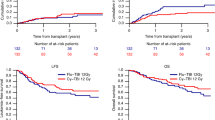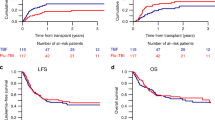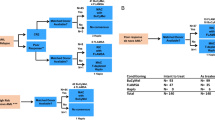Abstract
From 1989 to 1998, 341 children were included in the French multicentric LAME (Leucémie Aiguë Myéloblastique Enfant) trials. A total of 309 children were registered in the LAME 89/91 protocol. This intensive regimen included an induction phase (mitoxantrone plus cytarabine), two consolidation courses, one containing timed-sequential high-dose cytarabine, asparaginase and amsacrine; 276 (90%) achieved a CR. The 5-year overall survival (OS) and event-free survival (EFS) were 60±4 and 48±4%, respectively. From 1997, timed-sequencing of the LAME SP induction chemotherapy led to an unacceptable frequency of consolidation delay; future improvements are unlikely to come from further increases in intensity. The role of allogenic bone-marrow transplantation from an HLA-identical sibling in CR1 was examined. The disease-free survival (DFS) was 52±4% for non-allografted patients and 57±7% for allografted patients (P=NS); a better OS for allografted patients was shown and could be related either to allo-BMT early in CR1 or to a second allo-BMT in CR2. For the complete responders after consolidation therapy, the 5-year OS was significantly better in patients randomized for no maintenance therapy (MT−) than in patients randomized for MT (77.6±8 vs 59±8%; P=0.05), while the 5-year DFS was not significantly different. Exposure to low-dose MT might contribute to clinical drug resistance and treatment failure in relapsing patients.
This is a preview of subscription content, access via your institution
Access options
Subscribe to this journal
Receive 12 print issues and online access
$259.00 per year
only $21.58 per issue
Buy this article
- Purchase on Springer Link
- Instant access to full article PDF
Prices may be subject to local taxes which are calculated during checkout



Similar content being viewed by others
References
Marty M, Lepage E, Guy H, Bordessoule D, Desablens B, Harousseau JL et al. Remission induction and maintenance modalities in acute myeloid leukemia: a multicenter randomized study. Haematol Blood Transfus 1987; 30: 50–56.
Michel G, Leverger G, Leblanc T, Nelken B, Baruchel A, Landman-Parker J et al. Allogeneic bone marrow transplantation vs aggressive post-remission chemotherapy for children with acute myeloid leukemia in first complete remission. A prospective study from the French Society of Pediatric Hematology and Immunology (SHIP). Bone Marrow Transplant 1996; 17: 191–196.
Perel Y, Auvrignon A, Leblanc T, Vannier JP, Michel G, Nelken B et al. Impact of addition of maintenance therapy to intensive induction and consolidation chemotherapy for childhood acute myeloblastic leukemia: results of a prospective randomized trial, LAME 89/91. J Clin Oncol 2002; 20: 2774–2782.
Lie SO, Jonmundsson G, Mellander L, Siimes MA, Yssing M, Gustafsson G . A population-based study of 272 children with acute myeloid leukaemia treated on two consecutive protocols with different intensity: best outcome in girls, infants, and children with Down's syndrome. Nordic Society of Paediatric Haematology and Oncology (NOPHO). Br J Haematol 1996; 94: 82–88.
Lie SO, Abrahamsson J, Clausen N, Forestier E, Hasle H, Hovi L et al. Treatment stratification based on initial in vivo response in acute myeloid leukaemia in children without Down's syndrome: results of NOPHO-AML trials. Br J Haematol 2003; 122: 217–225.
Woods WG, Kobrinsky N, Buckley JD, Lee JW, Sanders J, Neudorf S et al. Timed-sequential induction therapy improves postremission outcome in acute myeloid leukemia: a report from the Children's Cancer Group. Blood 1996; 87: 4979–4989.
Ravindranath Y, Yeager AM, Chang MN, Steuber CP, Krischer J, Graham-Pole J et al. Autologous bone marrow transplantation vs intensive consolidation chemotherapy for acute myeloid leukemia in childhood. Pediatric Oncology Group. N Engl J Med 1996; 334: 1428–1434.
Stevens RF, Hann IM, Wheatley K, Gray RG . Marked improvements in outcome with chemotherapy alone in paediatric acute myeloid leukemia: results of the United Kingdom Medical Research Council's 10th AML trial. MRC Childhood Leukaemia Working Party. Br J Haematol 1998; 101: 130–140.
Webb DK, Harrison G, Stevens RF, Gibson BG, Hann IM, Wheatley K . Relationships between age at diagnosis, clinical features, and outcome of therapy in children treated in the Medical Research Council AML 10 and 12 trials for acute myeloid leukemia. Blood 2001; 98: 1714–1720.
Hann IM, Webb DK, Gibson BE, Harrison CJ . MRC trials in childhood acute myeloid leukaemia. Ann Hematol 2004; 83 (Suppl 1): S108–S112.
Creutzig U, Ritter J, Zimmermann M, Reinhardt D, Hermann J, Berthold F et al. Improved treatment results in high-risk pediatric acute myeloid leukemia patients after intensification with high-dose cytarabine and mitoxantrone: results of Study Acute Myeloid Leukemia-Berlin–Frankfurt–Munster 93. J Clin Oncol 2001; 19: 2705–2713.
Michel G, Gluckman E, Esperou-Bourdeau H, Reiffers J, Pico JL, Bordigoni P et al. Allogeneic bone marrow transplantation for children with acute myeloblastic leukemia in first complete remission: impact of conditioning regimen without total-body irradiation – a report from the Societe Francaise de Greffe de Moelle. J Clin Oncol 1994; 12: 1217–1222.
Aladjidi N, Auvrignon A, Leblanc T, Perel Y, Benard A, Bordigoni P et al. Outcome in children with relapsed acute myeloid leukemia after initial treatment with the French Leucemie Aique Myeloide Enfant (LAME) 89/91 protocol of the French Society of Pediatric Hematology and Immunology. J Clin Oncol 2003; 21: 4377–4385.
Woods WG, Neudorf S, Gold S, Sanders J, Buckley JD, Barnard DR et al. A comparison of allogeneic bone marrow transplantation, autologous bone marrow transplantation, and aggressive chemotherapy in children with acute myeloid leukemia in remission. Blood 2001; 97: 56–62.
Delaunay J, Vey N, Leblanc T, Fenaux P, Rigal-Huguet F, Witz F et al. Prognosis of inv(16)/t(16;16) acute myeloid leukemia (AML): a survey of 110 cases from the French AML Intergroup. Blood 2003; 102: 462–469.
Nguyen S, Leblanc T, Fenaux P, Witz F, Blaise D, Pigneux A et al. A white blood cell index as the main prognostic factor in t(8;21) acute myeloid leukemia (AML): a survey of 161 cases from the French AML Intergroup. Blood 2002; 99: 3517–3523.
Wells RJ, Woods WG, Lampkin BC, Nesbit ME, Lee JW, Buckley JD et al. Impact of high-dose cytarabine and asparaginase intensification on childhood acute myeloid leukemia: a report from the Childrens Cancer Group. J Clin Oncol 1993; 11: 538–545.
Riley LC, Hann IM, Wheatley K, Stevens RF . Treatment-related deaths during induction and first remission of acute myeloid leukaemia in children treated on the Tenth Medical Research Council acute myeloid leukaemia trial (MRC AML10). The MCR Childhood Leukaemia Working Party. Br J Haematol 1999; 106: 436–444.
Buchner T, Hiddemann W, Berdel WE, Wormann B, Schoch C, Fonatsch C et al. 6-Thioguanine, cytarabine, and daunorubicin (TAD) and high-dose cytarabine and mitoxantrone (HAM) for induction, TAD for consolidation, and either prolonged maintenance by reduced monthly TAD or TAD-HAM-TAD and one course of intensive consolidation by sequential HAM in adult patients at all ages with de novo acute myeloid leukemia (AML): a randomized trial of the German AML Cooperative Group. J Clin Oncol 2003; 21: 4496–4504.
Wells RJ, Woods WG, Buckley JD, Odom LF, Benjamin D, Bernstein I et al. Treatment of newly diagnosed children and adolescents with acute myeloid leukemia: a Childrens Cancer Group study. J Clin Oncol 1994; 12: 2367–2377.
Hu XF, Slater A, Kantharidis P, Rischin D, Juneja S, Rossi R et al. Altered multidrug resistance phenotype caused by anthracycline analogues and cytosine arabinoside in myeloid leukemia. Blood 1999; 93: 4086–4095.
van den Heuvel-Eibrink MM, Wiemer EA, de Boevere MJ, van der Holt B, Vossebeld PJ, Pieters R et al. MDR1 gene-related clonal selection and P-glycoprotein function and expression in relapsed or refractory acute myeloid leukemia. Blood 2001; 97: 3605–3611.
van den Heuvel-Eibrink MM, Wiemer EA, Prins A, Meijerink JP, Vossebeld PJ, van der Holt B et al. Increased expression of the breast cancer resistance protein (BCRP) in relapsed or refractory acute myeloid leukemia (AML). Leukemia 2002; 16: 833–839.
Steinbach D, Sell W, Voigt A, Hermann J, Zintl F, Sauerbrey A . BCRP gene expression is associated with a poor response to remission induction therapy in childhood acute myeloid leukemia. Leukemia 2002; 16: 1443–1447.
Liang DC, Shih LY, Hung IJ, Yang CP, Chen SH, Jaing TH et al. FLT3-TKD mutation in childhood acute myeloid leukemia. Leukemia 2003; 17: 883–886.
Tse KF, Allebach J, Levis M, Smith BD, Bohmer FD, Small D . Inhibition of the transforming activity of FLT3 internal tandem duplication mutants from AML patients by a tyrosine kinase inhibitor. Leukemia 2002; 16: 2027–2036.
Feuring-Buske M, Frankel AE, Alexander RL, Gerhard B, Hogge DE . A diphtheria toxin-interleukin 3 fusion protein is cytotoxic to primitive acute myeloid leukemia progenitors but spares normal progenitors. Cancer Res 2002; 62: 1730–1736.
Watarai M, Miwa H, Shikami M, Sugamura K, Wakabayashi M, Satoh A et al. Expression of endothelial cell-associated molecules in AML cells. Leukemia 2002; 16: 112–119.
Sievers EL, Lange BJ, Sondel PM, Krailo MD, Gan J, Tjoa T et al. Children's cancer group trials of interleukin-2 therapy to prevent relapse of acute myelogenous leukemia. Cancer J Sci Am 2000; 6 (Suppl 1): S39–S44.
Author information
Authors and Affiliations
Consortia
Corresponding author
Additional information
Supplementary Information accompanies the paper on the Leukemia website (http://www.nature.com/leu).
Rights and permissions
About this article
Cite this article
Perel, Y., Auvrignon, A., Leblanc, T. et al. Treatment of childhood acute myeloblastic leukemia: dose intensification improves outcome and maintenance therapy is of no benefit – multicenter studies of the French LAME (Leucémie Aiguë Myéloblastique Enfant) Cooperative Group. Leukemia 19, 2082–2089 (2005). https://doi.org/10.1038/sj.leu.2403867
Received:
Accepted:
Published:
Issue Date:
DOI: https://doi.org/10.1038/sj.leu.2403867
Keywords
This article is cited by
-
General Anesthesia for Pediatric Patients with Leukemia
SN Comprehensive Clinical Medicine (2019)
-
Metabolic syndrome in adults who received hematopoietic stem cell transplantation for acute childhood leukemia: an LEA study
Bone Marrow Transplantation (2015)
-
Impact on long-term OS of conditioning regimen in allogeneic BMT for children with AML in first CR: TBI+CY versus BU+CY: a report from the Société Française de Greffe de Moelle et de Thérapie Cellulaire
Bone Marrow Transplantation (2014)
-
Pediatric Relapsed or Refractory Leukemia: New Pharmacotherapeutic Developments and Future Directions
Drugs (2013)
-
Treatment results of childhood acute myeloid leukemia in Serbia
memo - Magazine of European Medical Oncology (2013)



